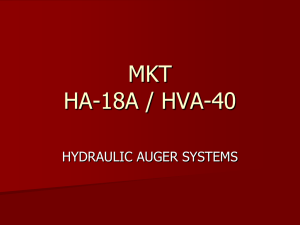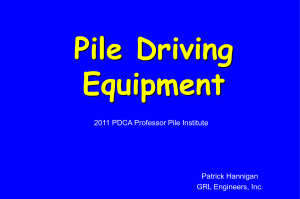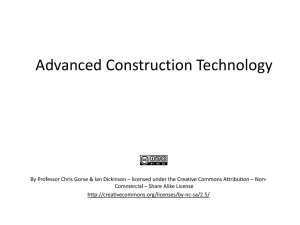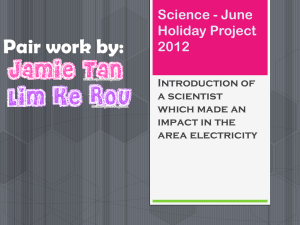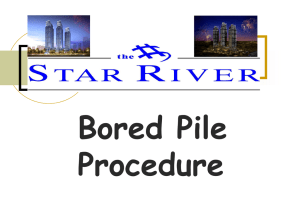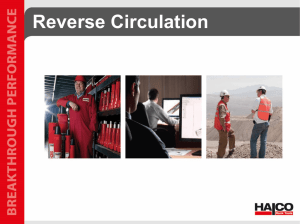Vibratory Hammers:
advertisement
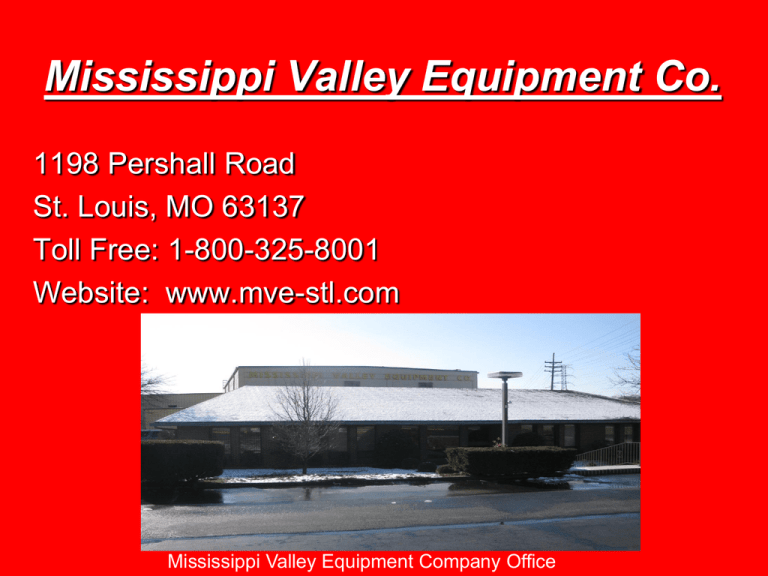
Mississippi Valley Equipment Co. 1198 Pershall Road St. Louis, MO 63137 Toll Free: 1-800-325-8001 Website: www.mve-stl.com Mississippi Valley Equipment Company Office A Winning Team!! Mississippi Valley Equipment Co. Mississippi Valley Equipment was founded in St. Louis, MO in 1933 We are a distributor of MKT Pile Driving and Drilling Equipment: vibratory hammers, hydraulic augers, hydraulic impact hammers, air hammers, leads, accessories, SPI diesel hammers, and custom / design manufacturing, etc. 1.) 3 Main Components of a vibratory driver / extractor system 1.) Diesel-driven hydraulic power unit MKT HP-365 power unit 3 Main Components of a vibratory driver / extractor system (cont.): 2.) Pressure-rated hydraulic hose bundle 3 Main components of a vibratory driver / extractor system (cont.): 3.) Exciter case fitted w/ suspension and hydraulic clamp assemblies to fit different applications MKT V-22 w/ caisson beam 2.) How a hydraulic vibratory driver / extractor system works: A.) A vibratory hammer drives a pile through a combination of driving force, frequency, amplitude, and freehanging weight. The driving force of a hammer is determined by it’s eccentric moment & steady-state frequency. MKT V-52 w/ caisson beam How a vibratory driver / extractor system works (cont.): Eccentric Moment – term used to describe the effectiveness of a force to produce rotation about an axis. It is the value in inch-pounds equal to the weight of the eccentric multiplied by the distance from the center-line of gravity to the center-line of rotation, then multiplied by the total number of eccentrics used in the machine. How a vibratory driver / extractor system works (cont.): The size of the eccentric moment affects the driving force, attainable amplitude, operating frequency, and power requirements for the hammer Eccentric moment = distance from center line of gravity to center line of rotation, times total # of eccentrics in machine How a vibratory driver / extractor system works (cont.): Amplitude – the vertical movement of the total vibrating system, and the direct result of the applied force generated by the rotating eccentrics a.) amplitude = (eccentric moment) (vibrating mass) X2 b.) the “vibrating mass” consists of the weight of the hammer + the total pile weight How a vibratory driver / extractor system works (cont.): Amplitude (cont.) Example: AN MKT V-22 vibratory driver / extractor is driving 40’ PZ-27 sheet pile: What amplitude can the contractor expect? PZ-27 = 40.5 lbs/ft x 40’ (sheet length) = 1,620lbs x 2 (driven in pairs) = 3,240 (total weight of pair) 2,600 in/lbs (eccentric moment) 8,750 (V-22 weight) + 3,240 (pile weight) X2 (2,600) (11,990) X 2 = (.216) x 2 = .432 amplitude, or 7/16” amplitude How a vibratory driver / extractor system works (cont.): Amplitude (cont.) As a rule of thumb, for effective driving the hammer must have amplitude of equal to or greater than ¼” Generally speaking, the higher the amplitude, the more effective the hammer will be at driving pile in soils considered marginal to vibratory driving Higher amplitudes may also increase risk of damage to adjacent structures. Be sure to have trained professionals carefully evaluate soils & project information How a vibratory driver / extractor system works (cont.): Frequency = the number of cycles, or rotations per minute the system can achieve while free-hanging Steady-State Frequency = the number of cycles per minute the system can achieve while attached to a pile and introduced to the dampening characteristics of the soil being penetrated How a vibratory driver / extractor system works (cont.): Free-hanging weight – the overall weight of the hammer, in combination with it’s frequency & driving force, helps to drive the pile. Bias weights can be added to the hammer in cases where soils are considered marginal to vibratory driving MKT V-22 with bias weight How a vibratory driver / extractor system works (cont.) In order to effectively drive a pile, work must be done. To do work, force must be exerted through a given distance. In a vibratory hammer, this force is generated through the rotating eccentrics. This is also known as centrifugal force. How a vibratory driver / extractor system works (cont.): The eccentrics of a vibratory hammer are attached to a shaft, and are mounted in pairs opposite one another, on a horizontal plane inside the gearbox. The pinion shaft(s) are connected to a hydraulic motor/motors mounted to the outside of the gear box. As the eccentrics rotate in opposite directions, their horizontal forces cancel one another out, leaving only vertical vibration (see following diagram) How a vibratory driver / extractor system works (cont.): Position # 1 Position # 2 Position # 3 Position # 4 How a vibratory driver / extractor system works (cont.): By virtue of being firmly clamped to the pile, the vertical vibration created in the gearbox by the rotating eccentrics is transmitted into the pile being driven. The vibrations exerted through the pile and then into the soil cause a process referred to as soil liquefaction. This occurs when the loose, granular particles in the soil become loose & jumbled, or liquefied. The shearing action created by the vibration of the pile coupled with the combined weight of the hammer & pile allows for the pile to be driven through the “liquefied” soil. How a vibratory driver / extractor system works (cont.): The upward vertical vibrations created by the rotating eccentrics in the hammer are absorbed by the hammer’s suspension assembly, or suppressor assembly. This assembly contains a number of rubber elastomers, which absorb the vibrations imparted by the hammer and prevent damage to the crane boom. The elastomers should be periodically inspected when hammer is being used regularly. They can break, or “pop”, in hard driving conditions 3.) Vibratory Hammer Set-Up 1.) Be sure that hydraulic power unit is set on level ground MKT HP-700 power unit Vibratory Hammer Set-up (cont.) 2.) Connect hydraulic hose bundle to power unit (quick couplers have the plug & couplers alternately matched to prevent incorrect hose connection). MKT Quick Disconnects Vibratory Hammer Set-up (cont.): Wipe & clean all connectors & couplers prior to connection in order to prevent system contamination -- can use simple diesel fuel Take great care not to damage hose bundle by kinking, cutting, running over, etc. After use make sure to wipe clean & plug/cap all connectors Vibratory Hammer Set-up (cont.): Check all fluid levels in engine prior to start-up Check radiator fluid level Check engine oil Vibratory Hammer Set-up (cont.) Check level of hydraulic fluid in reservoir to make sure it is not below the inspection gauge Check oil level in pump-drive Hydraulic reservoir Pump drive Vibratory Hammer Set-up (cont.): With the hammer level and in the vertical position, check exciter housing lubrication oil via sight glass on hammer. Oil level should not be allowed to drop below halfway in sight glass Vibratory Hammer Set-up (cont.): If reconnecting hydraulic lines, lift hammer in vertical position. Bleed clamp cylinder of any excess air that may have become trapped in the system. First make sure clamp is completely closed, in order to maintain pressure. Then bleed clamp via Allen wrench, as shown in picture on bottom right. Bleed clamp until fluid runs clear. Close clamp completely Bleed clamp using Allen wrench Cold Weather Vibro Set-Up / Start-Up 4.) Vibratory Hammer Operation 1.) Prior to driving or extracting, make sure top of pile is flush with bottom of inside of clamp housing. Failure to do so can cause unnatural stresses on jaws and clamp assembly resulting in potential failure of jaws and/or clamp components & system Vibratory Hammer Operation (cont.) Close jaws via clampclose switch on either remote pendant, or control panel. Pilot operated check-valves ensure jaws remain locked in place until powered in the other direction Vibratory Hammer Operation (cont.) Piles are driven by completely relaxing the hoist line once the hammer is properly clamped to the pile, and the vibration of the hammer is started MKT V-52 driving sheets Vibratory Hammer Operation (cont.) When a pile can be driven no further due to an overload of the pile/soil system, the frequency of the hammer will noticeably slow down If pile can be driven no further due to striking an impenetrable object, there will be a considerable drop-off in drive pressure and exciter will “dance” in place. To continue driving, object must be removed, or alternate method of driving must be selected (ex. impact hammer ) Vibratory Hammer Operation (cont.): Piles are extracted by tensioning the hoist line, while hammer is vibrating. Pulling capacity is limited by rating of suspension assembly and tensile strength of pile. 2nd crane line should be attached to adjacent pile (dead man) and drawn tight as a precautionary measure against sudden loss of load 5.) Service & Maintenance Vibratory hammers should be inspected regularly to keep in good operating condition. Proper maintenance begins w/ cleanliness. Make sure no foreign material enters hydraulic fluid circuit. All filters should be changed after initial (50) hours of operating time on new hammers. During normal operation these filters should be changed after every 200 hrs, or at least twice per year. On larger units (V-22, V-52), pump drive fluid should be changed approx every 500 hrs. Change exciter case oil after approx. 50 hrs drive time, or as needed Hydraulic fluid should be maintained at all times. Make sure all hydraulic hose connections are tight & leak-free. Service & Maintenance (cont.) Check hydraulic fluid level on tank before and during operation. Do not operate if fluid level registers below inspection gauge. In normal, safe operation of MKT vibratory system, hydraulic fluid temperatures should remain in range of 115 degrees Farenheit to 165 degrees farenheit. If hydraulic oil temperature becomes excessive (above 180 degrees), stop operation and consult w/ factory or nearest MKT factory authorized servicing distributor Service & Maintenance (cont.) MKT vibratory drivers / extractors typicallly uses a petroleum base gear oil, Shell Omala 220 or equivalent. If hammer is consistently being pushed beyond recommended duty cycle, or if hammer is being operated in excessively hot conditions, a synthetic alternative is available. Shell Omala 220 RL or equivalent. Our experience shows the synthetic oil reduces the hammer’s operating temperature by 15-20 degrees. In addition, the synthetic alternative offers superior corrosion protection, improved oxidation, and thermal stability Service & Maintenance (cont.) Warning: Do not start power unit if main pump has been inactive for a long time w/o first checking to make sure pump is full of oil. This will prevent the starting of the pump w/o the proper lubrication, which can potentially cause pump damage. To check the main pump remove the drain hose and visually inspect to determine there is the proper amount of oil. If oil must be added, extreme care must be taken to ensure cleanliness of oil, so as not to contaminate entire system. MKT recommends the oil being introduced to system pass through a 10 micron filter. Service & Maintenance (cont.) After start-up & operation of the hammer, check the following: Inspect lines for hydraulic leaks Inspect oil seal areas in pump drive & control valves for leaks Allow hydraulic oil temp to rise slightly above pour temp (preferably 30 degrees or more) before starting the hammer Before attaching to pile, open & close clamp jaws to ensure proper function Be sure hydraulic lines are free of kinks and they hang uniformly Always maintain a close check on lifting cable to ensure integrity 6.) Safety (general) Virtually all jobsite accidents that involve product operation, maintenance, and repair are caused by failure to follow fundamental safety rules or precautions. Accidents can often be avoided by identifying potentially unsafe situations before an accident occurs. Be cognizant of your surroundings and alert to potential hazards. Those operating the equipment should have the necessary training, tools, and skills to do so. Safety (cont.) Do not operate or perform any lubrication, maintenance, or repair on this equipment until you have read and understand the applicable information in the Operation & Maintenance manual. The information, specifications, and illustrations in the manuals are based on information available at the time it was written. The specs, torques, pressures, measurements, adjustments, illustrations, and other items can and do change at any time. These changes can effect the performance and service given to the product. Obtain the latest and most complete information about the product to be used prior to job start-up. MKT Manufacturing, Inc & MKT distributors have the most current information available. Safety (cont.) Use caution when removing filler caps, grease fittings, pressure taps, breathers or drain plugs. Hold a rag over the cap or plug to prevent being sprayed or splashed by hot liquids under pressure. Always wear hard hat, protective glasses, hearing protection, and other protective equipment as required. Avoid wearing loose fitting clothing or jewelry that can get caught on controls or other parts of equipment. Make certain all protective guards & covers are in place Use all cleaning solutions w/ care. Report all needed repairs. Safety (maintenance) To properly service the equipment, stop the hammer or drill, & engine. Disconnect battery whenever performing any maintenance or before servicing the electrical system. If engine has electric starters, disconnect and protect the battery ground leads to prevent accidental start-up NEVER attempt any repairs or adjustments to the engine or hammer while it is running. Do not attempt repairs or adjustment you do not understand. Call the factory! Use proper tools: replace or repair broken or damaged If applicable, block or restrain the equipment before performing maintenance. Do not adjust, or set, hydraulic pressures. Contact MKT to have a factory trained technician perform this work. Safety: Pressurized Air & Water Pressurized air or water can cause personal injury. When using pressurized air or water for cleaning, wear protective face shield, protective clothing, and protective shoes. The maximum air pressure must be below 30 psi, and maximum water pressure must be below 40 psi for cleaning purposes. Safety: Fluid Penetration Wear eye protection at all times when cleaning the cooling system. Pressurized water could cause debris and/or hot water to be blown, and result in personal injury. Always use a board or cardboard when checking for a leak. Fluid escaping under pressure, even through a pin-hole size leak, can penetrate body tissue, causing serious injury or death. Hot liquids coming into contact with skin can cause severe burns. If fluid is injected directly onto your skin, it must be treated by a doctor familiar with this type of injury immediately. Safety: Hoses, Lines, & Tubes Do not pull on, or attempt to move equipment, with hydraulic hoses. Move power unit closer to work if hoses do not reach. Replace any damaged or kinked hoses immediately. Failure to do so could result in personal injury or death. Do not lift, or support, hydraulic hoses w/ wire-rope slings. Do not attempt to pull out kinks in hydraulic hoses. Kinks can reduce the hose safety factor by up to 50%. Do not bend or strike high-pressure lines. Do not install bent or damaged lines, tubes, or hoses. Safety: Hoses, Lines, & Tubes (Cont.) Inspect all lines, tubes, and hoses carefully. Do not use bare hands to check for leaks….wear protective gloves. Tighten all connections to factory recommended torque. Repair any loose or damaged fuel and oil lines, tubes or hoses prior to equipment start-up. Leaks can cause fire and/or injury. Make sure that all clamps, guards, and heat shields are installed correctly to prevent vibration, rubbing against other parts, and excessive heat during operation. Do not allow hot oil to come into contact with skin, as it can cause severe burning and/or personal injury. Safety: Hoses, Lines, & Tubes (cont.) Before equipment start-up, check all lines, hoses and tubes for the following: 1.) End fittings damaged, leaking, or displaced 2.) Outer covering chafed or cut, and/or broken wires 3.) Outer covering ballooning locally 4.) Evidence of kinking or crushing Safety: Fire or Explosion Prevention All fuels, most lubricants, hydraulic oil, and some coolant mixtures are flammable. Diesel fuel & gasoline are obviously flammable. Mixing diesel and gasoline can be EXTREMELY explosive. Do not weld or flame-cut on pipes or tubes that contain flammable fluids. Clean them thoroughly with nonflammable solvent before working on them. Clean and tighten all electrical connections. Check regularly for loose or frayed electrical wires. Refer to maintenance schedules for intervals. Replace, repair, and / or tighten all loose or frayed electrical wires prior to equipment start-up. Wiring must be kept in good condition, properly routed, and firmly attached. Routinely inspect wiring for wear or deterioration. All wires and cables must be of the recommended gauge and fused. Always have a fire extinguisher available. Keep it inspected & serviced Safety: Crushing or Cutting Prevention Make sure equipment and attachments are properly supported when working underneath them. NEVER attempt adjustments while the engine is running unless otherwise specified in the equipment manual. Stay clear of all rotating and moving parts. Guards should be in place whenever maintenance is not being performed. Keep hands away from all hydraulic clamps once equipment is turned on. Keep objects away from fan blades. They will throw or cut any object or tool that falls or is pushed into them. Wear protective glasses when striking objects to avoid eye injury Wear hearing protection while equipment is in operation. Safety: Mounting & Dismounting Prior to mounting hammer, and before each lift, operator must review excavator/crane lifting capacity to determine weight of equipment is within the rated lifting capacity of the crane/excavator. Do not climb on, or jump off the equipment or stand on components that cannot support your weight. Use an adequate ladder. Always use steps and handholds when mounting / dismounting. Before Starting Hammer or Drill Make sure that all lifting equipment, including cranes, wire ropes, slings, hooks, shackles, etc., are properly sized for the worst case loads anticipated during operations. Check wire rope slings for tightness, and wire ropes for wear daily. If you have any questions about weights, specifications, or performance of the hammer or drill, contact MKT prior to start-up NEVER attempt to connect to quick-disconnect couplers while the power unit is running. Make sure that all ground vibrations will not damage adjacent structures or excavations. Make sure no one is working on or close to the equipment prior to startup Hammer and/or Drill Operation Only well-trained and experienced personnel should attempt to operate or maintain this equipment. Do not stand any closer to equipment than necessary when it’s in operation. Parts may loosen and fall. Piling may shatter or break. Do not operate the hammer, crane boom, piles, leads, wire rope and other equipment within 15’ of electrical power lines, transformers and other electrical equipment, or within such distance as required by applicable safety codes. Do not side-load crane boom or hammer. Dangerous crane boom or hammer damage may result. Always be sure that crane boom is aligned w/ center line of the pile. Hammer and / or Drill Operation Always use the pile handling / safety line to attach the pile to the hammer. This way, should the clamps suddenly lose hydraulic pressure, the pile will not fall to the ground. Leave the pile handling / safety line attached to the pile at all times until it is firmly stuck in the ground. 7.) Hammer Selection & Soils Analysis In order to accurately select a hammer for a given project, a basic understanding of both the hammer and soil system are necessary. However, this is not an exact science, and several factors should be taken into consideration. Successful pile-driving with a vibratory hammer is contingent on good knowledge of the site & soil conditions Hammer Selection & Soils Analysis (cont.): Analyze available soils information – read any and all available soils reports on the project. Important areas of concern on these reports include the blow count (also referred to a “N” value, or “SPT”), moisture content, type of soil, profile of pile to be driven, pile layout, etc. Hammer Selection & Soils Analysis (cont.): see attached The “N” value, or blow count, refers to the # of times it takes to drive an open-ended, hollow tube through 18” of material, using a 140lb drop hammer. The tube itself is referred to as a split-spoon sampler. The first 6” of soil are considered “disturbed” during this type of testing, and are thusly disregarded. The final 12” are collected and analyzed. Hammer Selection & Soils Analysis (cont.): Using the formula discussed earlier, calculate the hammer’s amplitude when clamped to the pile. Then compare / contrast this to any available soils analysis, project and / or pile info, etc. amplitude (inches) = (eccentric moment / vibrating mass) X 2 Soils Analysis (cont.) Please see memory stick for soils reports. Sheet Pile-Driving: Techniques Every precaution should be taken to select the proper type of pile, and to install them safely and effectively. When driving a sheet wall, take time to ensure the first pile is driven accurately, vertically, and / or plumb. It’s then much easier for subsequent piles to be interlocked with the first pile, which acts as a guide for the remainder of the wall. In general, sheets should be driven at a rate of 1 foot per minute or more, in order to prevent overdriving and potential damage to both the sheet pile and the hammer Sheet Pile-Driving: Techniques 1.) Set & Drive Method: The simplest way of driving a sheet wall. Each sheet pile is driven to it’s full depth before setting the next pile. Can only be utilized as an effective installation method in loose soils w/ short pilings Sheet Pile-Driving: Techniques 2.) Panel Driving Method: Helps ensure good verticality & alignment. Minimizes risk of installation difficulties by driving out of interlock. Drive 1st set of sheets fully, then set the next 3 sets. Once those pairs are set, fully drive the final pair. Then drive remainder of panel, working backwards towards the 1st pair. The last pair of the first panel becomes the 1st pair of the 2nd panel. Because the whole panel has been set, it’s unnecessary to drive all piling fully in order to continue operations. If obstructions are encountered, individual pilings can be left high without fear of disruption to progress of setting the wall Sheet Pile-Driving: Techniques 3.) Staggered Driving – Preferred method in difficult soil conditions. Pilings are installed using a template, then driven in short steps. If soils are very dense, piles can be reinforced using pile shoes, or pile tips. If driving slows to less than 1 foot per minute, a larger hammer (if possible) or alternate method of driving is strongly recommended. Sheet Pile-Driving: Cofferdams 1.) Panel-driving method (rectangular): Before driving commences adjacent to a corner pile, make sure the crane has sufficient reach to enable each pile to be interlocked into the previously set pile. Working around the perimeter, the final and closing panel (which should include a corner pile), must be set & interlocked with the partly driven 1st pair of pilings. This ensures closure of the cofferdam. Sheet Pile-Driving: Cofferdams 2.) Set & Drive Method (rectangular): Piledriving operations should start & stop at (5) double pilings from the final corner. Closure of the cofferdam is achieved by adjusting the alignment of the wall either inwards or outwards to suit the dimension of the pilings being used. It’s important to maintain verticality of the pilings in order that they can be properly & safely interlocked Sheet Pile Driving: Cofferdams 3.) Driving Circular Cofferdams: For small cofferdams, when possible, set & interlock all pilings around a driving template prior to driving them to their full depth. Driving should progress in stages using a short leading increment of one pile to the adjoining pile. In large circular cofferdams, verticality is usually maintained using panel-driving techniques to facilitate closure of the cofferdam. May also be necessary to re-arrange final panel by increasing or reducing the radius of the cofferdam, or by introducing a specially fabricated pile.

